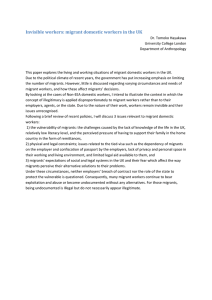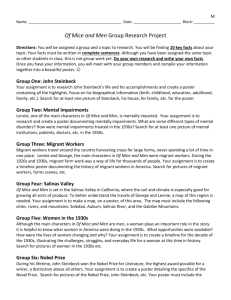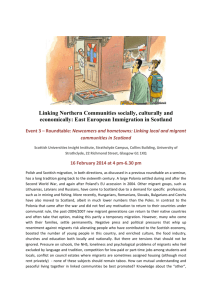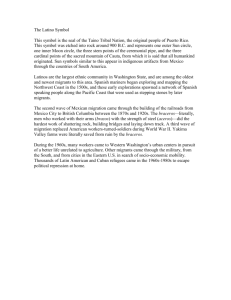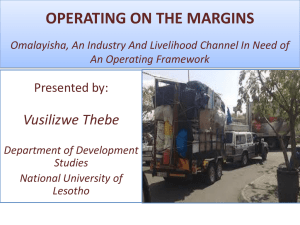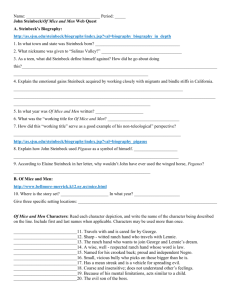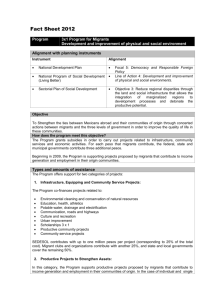Of Mice and Men: Historical Context - Great Depression
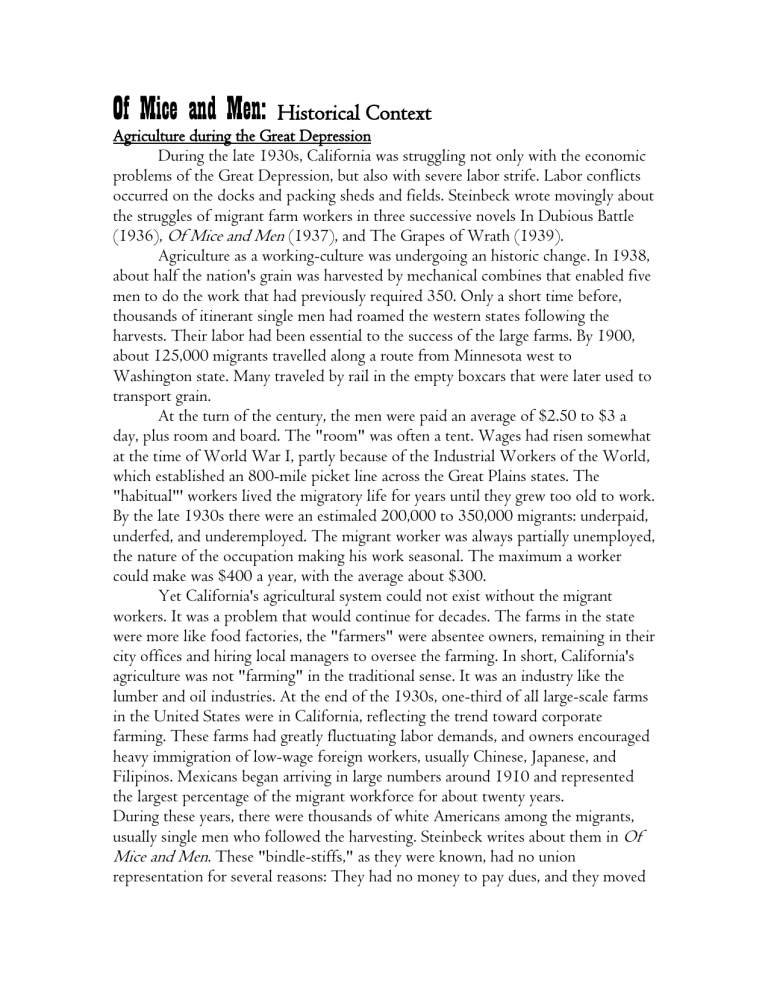
Of Mice and Men:
Historical Context
Agriculture during the Great Depression
During the late 1930s, California was struggling not only with the economic problems of the Great Depression, but also with severe labor strife. Labor conflicts occurred on the docks and packing sheds and fields. Steinbeck wrote movingly about the struggles of migrant farm workers in three successive novels In Dubious Battle
(1936),
Of Mice and Men
(1937), and The Grapes of Wrath (1939).
Agriculture as a working-culture was undergoing an historic change. In 1938, about half the nation's grain was harvested by mechanical combines that enabled five men to do the work that had previously required 350. Only a short time before, thousands of itinerant single men had roamed the western states following the harvests. Their labor had been essential to the success of the large farms. By 1900, about 125,000 migrants travelled along a route from Minnesota west to
Washington state. Many traveled by rail in the empty boxcars that were later used to transport grain.
At the turn of the century, the men were paid an average of $2.50 to $3 a day, plus room and board. The "room" was often a tent. Wages had risen somewhat at the time of World War I, partly because of the Industrial Workers of the World, which established an 800-mile picket line across the Great Plains states. The
"habitual"' workers lived the migratory life for years until they grew too old to work.
By the late 1930s there were an estimaled 200,000 to 350,000 migrants: underpaid, underfed, and underemployed. The migrant worker was always partially unemployed, the nature of the occupation making his work seasonal. The maximum a worker could make was $400 a year, with the average about $300.
Yet California's agricultural system could not exist without the migrant workers. It was a problem that would continue for decades. The farms in the state were more like food factories, the "farmers" were absentee owners, remaining in their city offices and hiring local managers to oversee the farming. In short, California's agriculture was not "farming" in the traditional sense. It was an industry like the lumber and oil industries. At the end of the 1930s, one-third of all large-scale farms in the United States were in California, reflecting the trend toward corporate farming. These farms had greatly fluctuating labor demands, and owners encouraged heavy immigration of low-wage foreign workers, usually Chinese, Japanese, and
Filipinos. Mexicans began arriving in large numbers around 1910 and represented the largest percentage of the migrant workforce for about twenty years.
During these years, there were thousands of white Americans among the migrants, usually single men who followed the harvesting. Steinbeck writes about them in
Of
Mice and Men
. These "bindle-stiffs," as they were known, had no union representation for several reasons: They had no money to pay dues, and they moved
from location to location so often that it was difficult to organize them.
In addition, American unionism, with its traditional craft setup, did not welcome unskilled workers like farm laborers. In 1930, the Cannery and Agricultural
Workers Industrial Union, a Communist-led union, organized the first effective drive among the migrants. During 1933, the group followed the migrants and harvests, organizing a nine-county cotton pickers' strike that affected 12,000 workers. By mid-1934 the union had led about fifty strikes involving 50,000 workers. The group's leaders claimed to have a membership of 21,000 and said they had raised the basic hourly field wage from an average of 15 cents to 17.5 cents an hour in 1932 to an average of 27.5 cents in 1934.
In the summer of 1934, the union was broken up by the anti-Communist activities of employers and state authorities. Its last stand was at an apricot pickets strike in June 1934. Deputies herded 200 strikers into a cattle pen, arrested some of the leaders, and transported the rest of the strikers out of the county. In trials, the union's president and secretary and six of their associates were convicted of treason.
Five of the eight prisoners were later paroled and the other three were freed when an appellate court reversed the convictions in 1937.
The existence of a strike was the greatest threat to California's growers. The harvest could wait while negotiations dragged on. Crops had to be picked within a few days of ripening or the result would be financial ruin. This situation created much social unrest. In the 1930s, vigilante activity against strikers and organizers was bloody. Many workers, as well as a number of strike breakers and townspeople, were injured. Vigilantism was not uncommon in early union activities, but in
California's farming industry it was particularly vicious, which was odd because the growers could not have existed without the migrants' labor. During peak seasonal demand, growers hired as many as 175,000 workers. Yet after the harvests most of these workers were not needed. Growers argued that they could not be responsible for paying workers year-round when they were needed only for a few weeks or months. Steady work was impossible not only because of the seasonal nature of the industry, but also because jobs were widely separated and time was lost traveling on the road.
Steinbeck wrote
Of Mice and Men
at a time when he was becoming involved in California's social and economic problems. In the novel, he wrote about a group of people, the white male migrant workers, who were to shortly disappear from
American culture. World War II absorbed many of the workers in the war effort in the 1940s. Although farm workers were generally exempt from the draft, the expansion of the defense industries to supply the U.S. military needs reduced the pool of surplus labor. The novel's continued popularity over the decades clearly shows that it has transcended its historical times.
